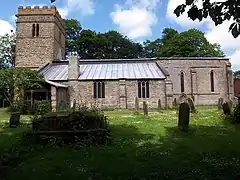Adrian Woodruffe-Peacock
The Reverend (Edward) Adrian Woodruffe-Peacock FLS FGS (23 July 1858 – 3 February 1922) was an English clergyman and ecologist. He was an early exponent of the ecological approach to natural history recording.[1]
Early life

Woodruffe-Peacock, always known by his middle name of Adrian, was born at Bottesford Manor, north Lincolnshire, on 23 July 1858, the son of Edward Peacock (1831–1915), farmer, antiquarian, historian, and author, and his wife, Lucy Ann Wetherell (1823–1887).[1] He had 6 siblings, including the folklorist Mabel Peacock. He was schooled at Edinburgh Academy (1870–73) and St Peter's School, York (1873).[1] He then received private tuition in Lincolnshire until April 1877, when he was admitted to St John's College, Cambridge, to study mathematics, classics, science, and natural history. Shortage of money, poor health, and the decision to become an Anglican clergyman cut short his stay there.[1]
In 1879 he transferred to Bishop Hatfield's Hall at Durham University.[1] At Durham, he indulged in extensive botanising, boating, and tennis; his social life being so time-consuming that there were complaints he regarded the university as a private club.[2] He sat for the degree examination at Easter 1881, but "scratched", thinking that he had failed his Latin paper and choosing to make arrangements to leave before receiving the results.[2] However, this did not affect his career as he had already obtained his licentiate of theology in December 1880, and was subsequently ordained deacon in December 1881, and then priest in December 1883.[1] Following university he held curacies at Long Benton, Northumberland (1881–84); Barkingside, Essex (1884–85); Long Benton (1885–86); and finally at Harrington, Northamptonshire (1886–90).[1]
Ecology

In 1891 he accepted the living at Cadney, 10 miles from his birthplace, where he stayed until 1920 and developed a reputation as a naturalist. This was a poor, sparsely populated parish; since Woodruffe-Peacock had to visit his widely scattered parishioners on foot, he became by inclination and necessity a tremendous walker, which afforded him the opportunity to make regular observations and to record the natural changes occurring over a limited area.[3] His profile in the Oxford Dictionary of National Biography notes that his routes contained some of the best observed and documented habitats in the country.[1]

Woodruffe-Peacock compiled a Critical Catalogue of Lincolnshire Plants (1894–1900), superseded by his Check-List of Lincolnshire Plants (1909), allegedly based on an analysis of half a million observations.[1] He took a leading role in the foundation of the Lincolnshire Naturalists' Union in 1893, serving as organizing secretary in 1895 and president in 1905. He was the prime mover in establishing a museum for Lincolnshire, his extensive herbarium forming an integral part of its original collections and the foundation of the city and county museum's herbarium. He was elected a fellow of both the Linnean Society and the Geological Society in 1895.[1] Among his achievements was the pioneering of the small-scale ecological survey.[4] He also appreciated the mechanisms of dispersal, a neglected aspect of British ecology, which he approached through the careful study of microhabitats.[4] As the result of "half a dozen visits" to a Lincolnshire beck during a dry summer when the water was low, he noted over 58 species growing, coming from the seeds he had dispersed by the stream.[4] He was also a pioneer in plotting the distribution of plants. As early as 1894 he had 20,000 "place notes" on the distribution of plant species tabulated in his "Locality Register".[4]
He published an article, "A fox-covert study" in the Journal of Ecology, recently founded by botanist Arthur Tansley.[5] The two eventually met on a field trip to Mildenhall in Suffolk and, surprisingly, since Tansley was an avowed atheist, became close friends.[6] By this point Woodruffe-Peacock had been working on a detailed study, Rock-soil flora of Lincolnshire, for many years, and Tansley, impressed, offered to contribute £300 towards its publication.[6] Owing to poor health, Woodruffe-Peacock was never able to make the necessary revisions and only a small section was ever published, the rest of the manuscript passing into the archives of Cambridge University Library.[6] According to Brian J. Ford, these extensive notes show him to be ahead of his time in his approach to natural history.[2]
Personal
Woodruffe-Peacock was tall and broad in proportion, but his health did not match up to his stature: most of his life he suffered from chronic hay fever and rheumatism.[1] In 1920, by now Rector of Grayingham, he suffered an emotional setback when his sister Mabel died. A combination of this, the pressures of his new appointment, and the disappointment of his magnum opus requiring so many revisions, saw his health break down.[2] He died on 3 February 1922 and was buried in an unmarked grave beside his sister.[1]
References
- Mark Seaward (23 September 2004). "Peacock, (Edward) Adrian Woodruffe- (1858–1922)". Oxford Dictionary of National Biography. Retrieved 12 August 2019.
- Ford, Brian J. (2000). "A Report of the Meeting 'John Ray and his Successors'". Notes and Records of the Royal Society. 54 (1): 5–22. doi:10.1098/rsnr.2000.0092. S2CID 143047192. Retrieved 12 August 2019.
- Mark R. D. Seaward (July 2010). "E. Adrian Woodruffe-Peacock (1858–1922): a pioneer ecologist". Archives of Natural History. 28 (1): 59–69. doi:10.3366/anh.2001.28.1.59. PMID 18290300.
- Armstrong, Patrick (2000). The English Parson-Naturalist: A Companionship Between Science and Religion. Gracewing. pp. 58–59. ISBN 9780852445167. Retrieved 2 January 2020 – via Google Books.
- Woodruffe-Peacock, E. Adrian (1918). "A Fox-Covert Study". Journal of Ecology. 6 (2): 110–125. doi:10.2307/2255362. ISSN 0022-0477. JSTOR 2255362.
- Ayres, Peter G. (21 May 2012). Shaping Ecology: The Life of Arthur Tansley. John Wiley & Sons. p. 139–140. ISBN 9780470671542. Retrieved 2 January 2020 – via Google Books.